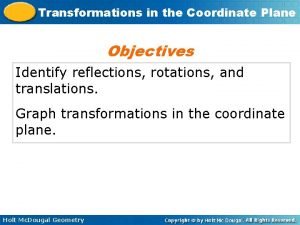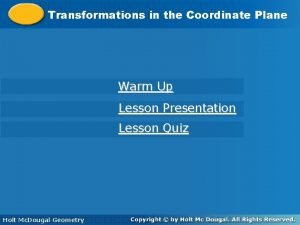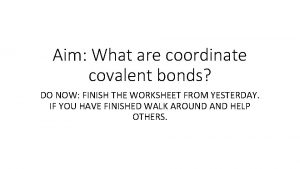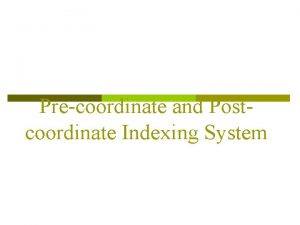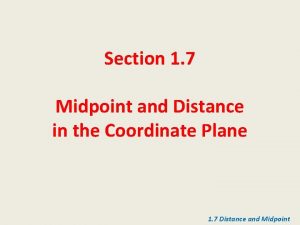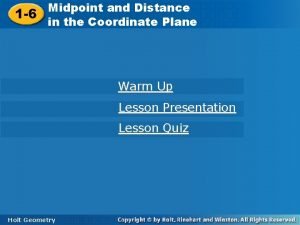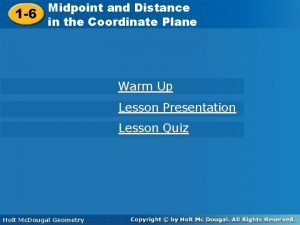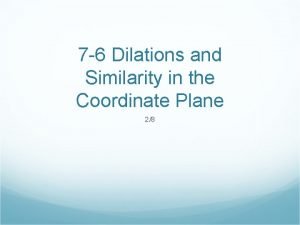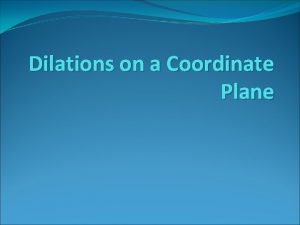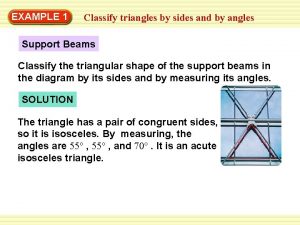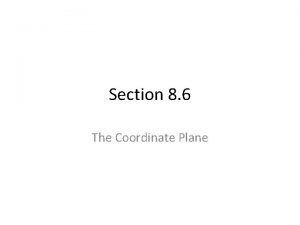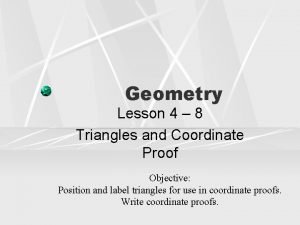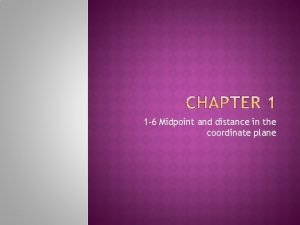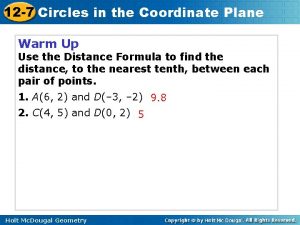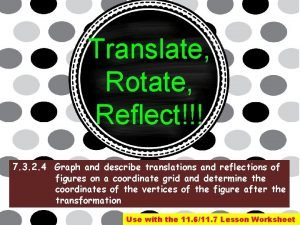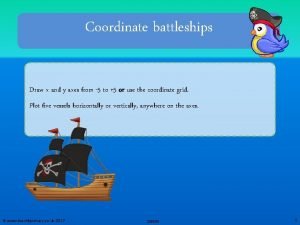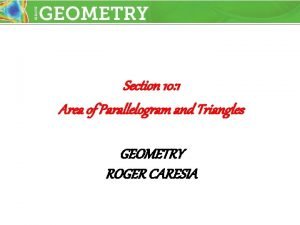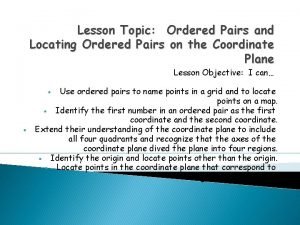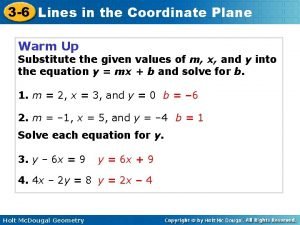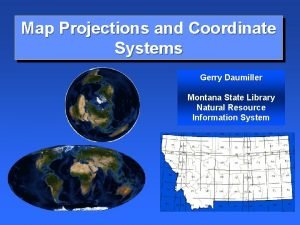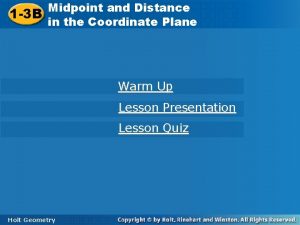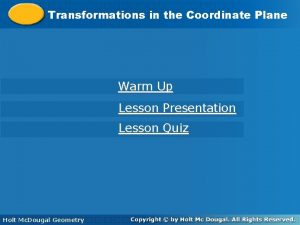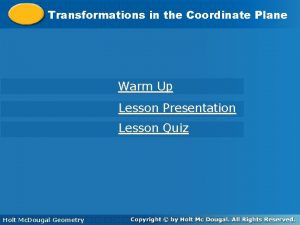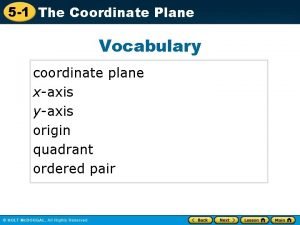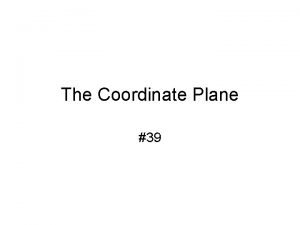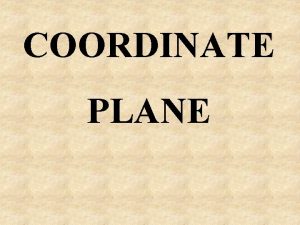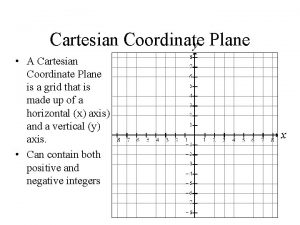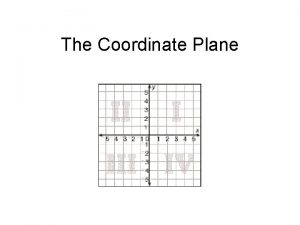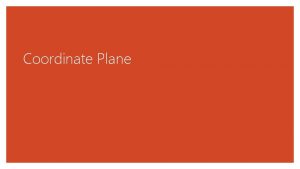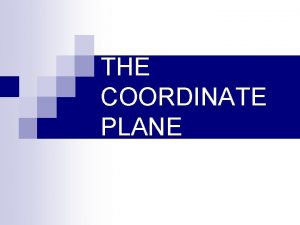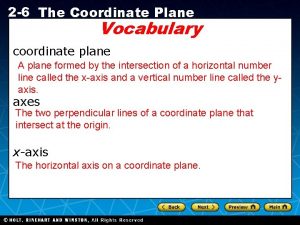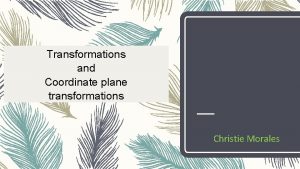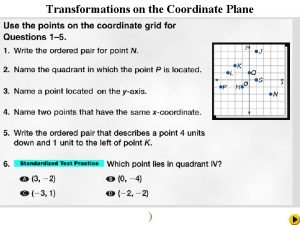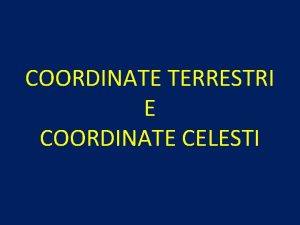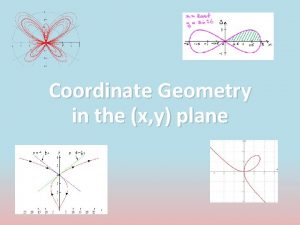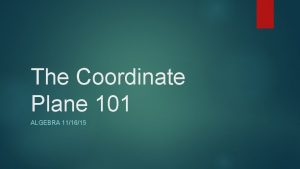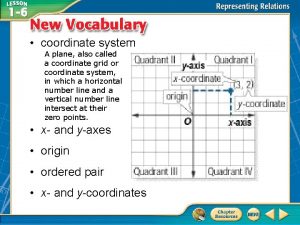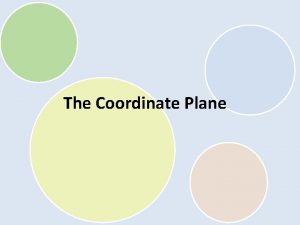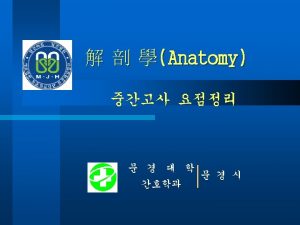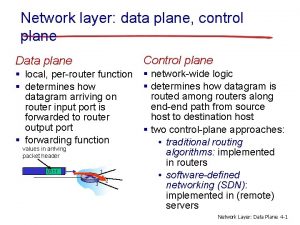Transformations on the Coordinate Plane Transformations are movements

























- Slides: 25

Transformations on the Coordinate Plane Transformations are movements of geometric figures. The preimage is the position of the figure before the transformation, and the image is the position of the figure after the transformation.

Transformations on the Coordinate Plane

Transformations on the Coordinate Plane Reflection: a figure is flipped over a line Translation: a figure is slid in any direction Rotation: a figure is turned around a point

Identify Transformations Identify the transformation as a reflection, translation, or rotation. Answer: The figure has been shifted horizontally to the right. This is a translation.

Identify Transformations Identify the transformation as a reflection, translation, or rotation. Answer: The figure has been turned around a point. This is a rotation.

Identify Transformations Identify the transformation as a reflection, translation, or rotation. Answer: The figure has been flipped over a line. This is a reflection.

Identify Transformations Identify each transformation as a reflection, translation, or rotation. a. b. Answer: rotation Answer: reflection c. Answer: translation

Transformations on the Coordinate Plane

Reflection A trapezoid has vertices W(– 1, 4), X(4, 4), Y(4, 1) and Z(– 3, 1). Trapezoid WXYZ is reflected over the y-axis. Find the coordinates of the vertices of the image. To reflect the figure over the y-axis, multiply each x-coordinate by – 1. (x, y)(–x, y) W(– 1, 4) (1, 4) X(4, 4) (– 4, 4) Y(4, 1) (– 4, 1) Z(– 3, 1) (3, 1) Answer: The coordinates of the vertices of the image are W (1, 4), X (– 4, 4), Y (– 4, 1), and Z (3, 1).

Reflection A parallelogram has vertices A(– 4, 7), B(2, 7), C(0, 4) and D(– 2, 4). a. Parallelogram ABCD is reflected over the x-axis. Find the coordinates of the vertices of the image. Answer: A (– 4, – 7), B (2, – 7), C (0, – 4), D (– 2, – 4)

Reflection b. Graph parallelogram ABCD and its image A B C D. Answer:

Transformations on the Coordinate Plane

Translation Triangle ABC has vertices A(– 2, 1), B(2, 4), and C(1, 1). Find the coordinates of the vertices of the image if it is translated 3 units to the right and 5 units down. To translate the triangle 3 units to the right, add 3 to the x -coordinate of each vertex. To translate the triangle 5 units down, add – 5 to the y-coordinate of each vertex. Answer: The coordinates of the vertices of the image are A (1, – 4), B (5, – 1), and C (4, – 4).

Translation Graph triangle ABC and its image. Answer: The preimage is The translated image is B . A C A B C

Translation Triangle JKL has vertices J(2, – 3), K(4, 0), and L(6, – 3). a. Find the coordinates of the vertices of the image if it is translated 5 units to the left and 2 units up. Answer: J (– 3, – 1), K (– 1, 2), L (1, – 1) b. Graph triangle JKL and its image. Answer:

Transformations on the Coordinate Plane

Dilation A trapezoid has vertices E(– 1, 2), F(2, 1), G(2, – 1), and H(– 1, – 2). Find the coordinates of the dilated trapezoid E F G H if the scale factor is 2. To dilate the figure, multiply the coordinates of each vertex by 2. Answer: The coordinates of the vertices of the image are E (– 2, 4), F (4, 2), G (4, – 2), and H (– 2, – 4).

Dilation Graph the preimage and its image. Answer: E The preimage is trapezoid EFGH. E The image is trapezoid E F G H . Notice that the image has sides that are twice the length of the sides of the original figure. F G H H F G

Dilation A trapezoid has vertices E(– 4, 7), F(2, 7), G(0, 4), and H(– 2, 4). a. Find the coordinates of the dilated trapezoid E F G H if the scale factor is Answer:

Dilation b. Graph the preimage and its image. Answer:

Transformations on the Coordinate Plane

Rotation Triangle ABC has vertices A(1, – 3), B(3, 1), and C(5, – 2). Find the coordinates of the image of ABC after it is rotated 180° about the origin. To find the coordinates of the image of ABC after a 180° rotation, multiply both coordinates of each point by – 1. Answer: The coordinates of the vertices of the image are A (– 1, 3), B (– 3, – 1), and C (– 5, 2).

Rotation Graph the preimage and its image. Answer: The preimage is The translated image is . A C B B A C

Rotation Triangle RST has vertices R(4, 0), S(2, – 3), and T(6, – 3). a. Find the coordinates of the image of RST after it is rotated 90° counterclockwise about the origin. Answer: R (0, 4), S (3, 2), T (3, 6) b. Graph the preimage and the image. Answer:

Homework Page 61 -63, #1 -7 Page 65, #9(a and b only) Page 67, #16 -19
 Insidan region jh
Insidan region jh 270 clockwise rotation rule
270 clockwise rotation rule Translation rule geometry
Translation rule geometry Transformations in the coordinate plane
Transformations in the coordinate plane Software-defined networking: a comprehensive survey
Software-defined networking: a comprehensive survey Is dancing a locomotor movement
Is dancing a locomotor movement Coordinate bond in co
Coordinate bond in co Pre coordinate indexing system
Pre coordinate indexing system Distance and midpoint formula
Distance and midpoint formula Lesson 1-6 midpoint and distance in the coordinate plane
Lesson 1-6 midpoint and distance in the coordinate plane 1-6 midpoint and distance in the coordinate plane
1-6 midpoint and distance in the coordinate plane Dilations and similarity in the coordinate plane
Dilations and similarity in the coordinate plane Distance on the coordinate plane
Distance on the coordinate plane Dilation rule
Dilation rule How to classify a triangle by its sides with coordinates
How to classify a triangle by its sides with coordinates Coordinate plane vocabulary
Coordinate plane vocabulary What proof uses figures
What proof uses figures Midpoint and distance in the coordinate plane worksheet
Midpoint and distance in the coordinate plane worksheet Circles in the coordinate plane
Circles in the coordinate plane Reflections on a coordinate plane worksheet
Reflections on a coordinate plane worksheet Coordinate plane battleship
Coordinate plane battleship Perimeter of a triangle on a coordinate plane
Perimeter of a triangle on a coordinate plane Locating ordered pairs on the coordinate plane
Locating ordered pairs on the coordinate plane 3-6 lines in the coordinate plane
3-6 lines in the coordinate plane Montana utm zones
Montana utm zones Practice b midpoint and distance in the coordinate plane
Practice b midpoint and distance in the coordinate plane


